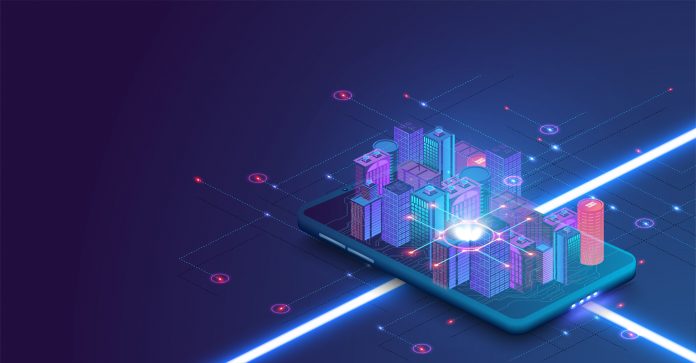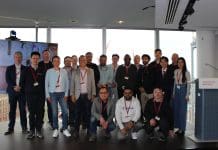Women in BIM core team members Rebecca De Cicco, director of Digital Node, Vicki Reynolds, chief technology officer at i3PT Certification, and Dr Jenni Barrett, director at coLAB and senior lecturer at the University of Central Lancashire, discuss what has impressed them the most in the past five years and what future technology trends they predict for 2021
Over the past few years, the built environment has witnessed significant transformational change, no less than in the introduction of new technologies such as Artificial Intelligence, robotics and the Internet of Things combined with the advancement of smart city technology and the digital twin.
As 2020 draws to a close, we begin to question what lies ahead for the future of construction and what will 2021 and beyond look like. We asked three global built environment experts for their views on what has worked well, what has been instrumental in driving digitalisation and what comes next.
What has impressed you the most in the digital built environment in the past five years?

Rebecca De Cicco: “As an advocate for global unity and having worked with governments and organisations all over the world, it is clear that the UK government’s commitment to the development of a BIM policy has been an impressive and incredibly forward-thinking approach toward change for an industry so desperately lagging behind.
“The globalisation of construction industry standards in the UK, with the development of the ISO 19650 series, was certainly a turning point and one that has been instrumental in export opportunities. I have seen that the use of technology and process in construction in this way has driven industry to upskill and educate and therefore brought about enormous change.
“The varying initiatives in the UK for BIM have influenced a wider digital debate with the development of the National Digital Twin (NDT) and the Information Management Framework to support the implementation of the NDT. These policies and principles are now seeing momentum globally, with the uptake of the terms used and the language around these concepts becoming more mainstream.”

Vicki Reynolds: “The built environment is vast, with an exceptionally broad range of stakeholder types, capability levels and needs. Often, when looking at the industry from a single angle it may seem that the rate of change is happening frustratingly slowly but, in reality, the job at hand is huge and driving change in an environment such as this is incredibly hard. With that in mind, I am proud and impressed by the progress we have made so far.
“The work of the UK BIM Alliance and the development of the ISO 19650 suite of BIM standards has been a considerable achievement, and the innovative work the Centre for Digital Built Britain (CDBB) is doing to explore and drive the use of digital twins across the built environment is incredibly exciting
“If you consider how, as an industry, we might have reacted to a global pandemic five years ago, it would have been very different – although pre-Covid we weren’t quite using digital tools day to day, we did at least have them available, making the transition to home working much easier than it would have been in 2015. We are certainly moving in the right direction.”

Jenni Barrett: “When I started working in UK construction in the early 1990s, the industry was considered adversarial and it was perceived to be lagging behind in comparison to some other industries. Communication was seen to be a key barrier to excellence and equally, innovation was lacking as supply chains, designers, contractors and different professional disciplines struggled to work together in a competitive environment. In recent years, however, the industry has changed, responding to the digital revolution as a shared goal.
“The digitalisation of communication has been a challenge and a real culture change for many businesses and particularly difficult for longstanding members of the industry who have been used to more traditional forms of collaboration for many years. But the industry has embraced this challenge and appropriated many forms of digital collaboration which have not only improved communication via standard forms such as email or online forums but also tailored portal solutions.
“This has brought us closer to each other, allowing us to develop good relationships and shared knowledge globally, rather than just with those in geographical proximity. It has also allowed us to communicate better with our clients, users and stakeholders.”
What has had the greatest impact in the shift to digitalisation?
De Cicco: “The work around international standards spins into the wider digital landscape for the implementation framework around smart cities. The UK has driven the adoption of the PAS suite of documents to also globalise the initiative, with the ISO 37106 and Smart City Standards being more widely used and acknowledged across the world. And with the development of the technology, it also comes with new skills and education requirements.
“The Skills Framework for the Information Age (SFIA) is a framework for describing and managing skills and competencies for professionals working in information and communication technologies, software engineering and digital transformation. This is by no means exempt when discussing skill requirements in construction and the acknowledgement of this framework and use of this documentation, but it is something I am very impressed by when it comes to change.
“As construction and digitalisation further infuse our current working environment, we are witnessing greater demand for enhanced technical compatibility and collaboration, and it is this visionary thinking that is influencing decisions makers the most.”
Reynolds: “Smart(er) machines that use machine learning to make better decisions and increase efficiency on site are no longer something we simply talk about; these now exist and are fully operational.
“Smart technology has the power to anticipate potential systemic transformations, enabling the necessary strategic dialogue needed to analyse change and, as a consequence, unlock new and visionary approaches to digital information management.
“This way of working allows us to reveal dynamic change and use these insights to reach sustainable solutions and greater building process efficiencies. Not to mention breaking through communication barriers and seeing how current and alternative development pathways may affect the future.”
Barrett: “Cloud-based, industry-wide initiatives are allowing us to close knowledge gaps and share visions to increase our potential for interdisciplinary thinking and generate more collaboration across the design chain to embrace the challenges of BIM and the possibilities that the internet of things might offer for the built environment.
“This is bringing about a change of culture and it’s one that will not only allow us to take advantage of the digital innovations that can improve our working practices and enable new business models, but also create better buildings. Better interdisciplinary thinking has empowered us to rethink the contracts that we work within and forced us to break out of our professional silos to create universal standards and real solutions to the challenges that lie ahead, such as climate change and inclusivity in design.
“This openness to change and improved communication has been brought into sharp focus by the global Covid pandemic. There have been years of dialogue about how the built environment might operate in a digital future, but lockdown restrictions motivated everyone to act quickly and to adopt many of these ideas about remote working and collaboration, even if the risks and pitfalls had not yet been resolved. This is a noticeable change in the construction industry, which had previously been so risk averse.”
What are your future technology trend predictions for 2021?
De Cicco: “As an industry, we are thwart with fear when it comes to how technology will begin to change how we live and work. Having said this, and being the digital evangelist I am, I feel that there is much to look forward to when looking to the future and how technologies will advance how we deliver simple tasks. For me, it is about using consistent frameworks for delivery.
This is very important when it comes to avoiding risk and dispute on projects and therefore more stringent rules around Information Management and the Information Management Framework both in the UK and globally is one way this can be achieved.
“Digital twin and smart cities are becoming common terms, but what I do predict is the implementation on a more detailed and advanced level of some of the concepts, not only driven by technology but also by the international standards to support the development of the Smart City Initiative and the uptake of ISO 37106, as well as ISO 37120 series for smart city indicators.
“As the world changes and our city infrastructure becomes more intelligent, it will be something that I feel will certainly be a big game-changer heading into 2021. Using open data, technological advancements to capture city data and then the use of individual digital twins to inform the wider city landscape, will certainly be driven more heavily in construction across the world.”
Reynolds: “Technology shapes so much around us and has long played an important role in our industry, influencing fundamental processes in design and operation. As we step into the next decade, two factors are the major players in the future of our ongoing digital transformation: the Golden Thread and digital twin.
“Implementation of the Golden Thread will change the way we work, potentially disrupting the way we manage contracts, with interoperability becoming key to success. Whereas, a digital twin of the built environment will be able to unlock the full potential of the virtual outcome-based service provision by linking the physical and virtual asset. These two factors are not stand alone and full digital integration will see an industry which builds faster and smart, in ways we have never witnessed before.
“The use of the digital twin ensures that data is always flowing and creating a digital twin network means new opportunities for the way we use and interpret data, allowing us to understand not only how our assets are performing but also predict how they will perform in the future.”
Barrett: “While the digital progression of construction has been impressive, we’ve still got a lot to do. But my prediction is that this trajectory of behaviour change will continue. I think we are at a tipping point in industry digitalisation where we will consolidate the knowledge we have gained so far and reflect on our experiences of 2020 to make significant changes to our organisational cultures.
“I believe we will refocus our thinking beyond the nuts and bolts of technology to think about how we use better the human beings that populate our industry. This will require radical shifts in the way contracts are set up and how project networks can collaboratively share the financial rewards for delivery, rather than maintaining the individualistic contract system that will decreasingly be fit for purpose in the networked digital environment.
“I also predict that human-centric skills, that are often sidelined due to the heavy load of mundane and repetitive tasks involved in project delivery, will become key areas for learning and talent acquisition.
“Artificial Intelligence (AI) and Machine Learning (ML) will be able to do these repetitive and mundane tasks, freeing up human time and intelligence to focus on creative thinking, innovation and strategic change. A number of other sectors, such as law and medicine, have already starting to work in this way. I predict that AI and ML will be further developed in an industry focused way to speed up communication flow and reduce communication overload, allowing information automatically to get to the right people at the right time.”
Women in BIM
Twitter: womeninbim
LinkedIn: womeninbim














